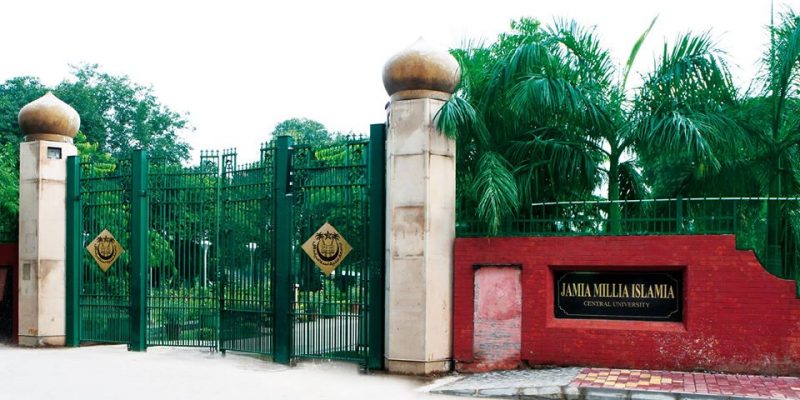“Jamia means university, and ‘Millia’ refers to its national character. The founders of the university were supported by Gandhi, who insisted the name should remain Jamia Millia Islamia and not be changed to National Muslim University. Together the founders built up Jamia “stone by stone”, said Sarojini Naidu, and “sacrifice by sacrifice”.
Men such as Hakim Ajmal Khan hoped to make Hindu children learn something of Islam, and Muslim children something of Hinduism. They hoped ‘a united Indian nationalism’ would emerge from this knowledge each community would gain of the other, a nationalism that was meant to be both pragmatic and non-sectarian.”
∼ Githa Hariharan in The Telegraph when Jamia’s image was being tarnished in the backdrop of the Batla House encounter in 2008.
Less than a year ago from now, Jamia Millia Islamia was yet again in turmoil, which began with a protest against CAA-NRC, followed by spiralled events leading to police action that left many a student injured. And then began a strenuous and venomous attempt to malign this historic institution by select electronic media. So much so, a panelist on one of the television debate aired on February 16, 2020 claimed: “…today’s Jamia Islamia is becoming Aligarh Muslim University of pre-partition era…” As a co-panelist on the same show, I took a serious objection to this prejudiced view, but I immediately sensed how logical arguments most often get lost amidst shouting on such debates.
As Jamia Millia Islamia completed its centenary on October 29, 2020, it is befitting to reflect upon the ‘idea of Jamia’; how it carved its own journey from within Aligarh Muslim University; and how this idea was in sync with the ‘Idea of India’ – multicultural, secular and inclusive.
On October 12, 1920, Mahatma Gandhi while addressing a group of students assembled at the Siddons Union Club at Aligarh Muslim University had asked: “How can you remain even for an hour in an institution in which you are obliged to put up with the Union Jack and profess your loyalty to a governor or other high ranking officials when in fact you are not loyal?”
Gandhi’s call for a complete boycott of the institutions of learning which were funded and administered by the British colonial masters provided serious food for thought amongst some young revolutionaries and the university campus soon started getting divided between two opposing camps, one being the proponents of status quo wanting to serve the colonialism and other ready to leave AMU towards a sacrifice for the cause of the motherland.
It was at this very juncture that the ‘idea of Jamia’ was born with a call for ‘national education in a national institution’. The concept of Nai-Talim, a skill-based education and preference for Hindustani as a medium of instruction further enriched this idea.
With its humble beginning at Aligarh, Jamia Millia Islamia had to immediately shun the eclipse of an already established Aligarh Muslim University, and hence it moved to Delhi in 1925. With an unambiguous vision as expounded by one of its founder, Mohammad Ali ‘Johar’:
“Jamia’s objective is that Muslim should (not) follow blindly the previous fixed path…the Jamia instilled hatred in the heart of every student be he a Muslim or a Hindu – against subjugation by foreign powers. It has kept its air free of transgression and prejudice. For these reasons the Jamia is both Jamia Millia Islamia and a national university.”
But what Jamia eventually went on to become has been best explained by Martha C. Nussbaum. For her, “Jamia was born radical; its curriculum emphasised study of nationalism as well as Islamic history; its admission policy welcomed male, female, Hindu, Muslim; its pedagogy emphasised debate and contestation in the teaching of all subjects, including religion denouncing the mere passive awareness of dead facts.”
For long years since its inception, even the degrees offered by Jamia were not recognised, not to mention how financial afflictions continued. It was only in 1962 that JMI was bestowed upon with a tag of ‘deemed to be university’. Finally in 1988, by an act of the Indian parliament, Jamia became a central university.
Interestingly enough, despite the word ‘Islamia’ in its very name, Jamia Millia Islamia was never a Muslim university; not even a minority institution until 2011 when National Commission for Minority Educational institutions declared Jamia a minority university. But Jamia Millia Islamia continues to hold the central university status.
There is no denying the fact that the very demographic location of today’s Jamia Millia Islamia is surrounded by substantive Muslim populace, but as Sachar Committee report had rightly observed that the social and educational backwardness of the Muslim community in India is no better than the status of the scheduled castes and thus Jamia comes as a blessing in disguise for the community too.
A university, in any case, is supposedly meant to serve as an intellectual lamp-post for the community and Jamia Millia Islamia as a dual-mode university with a national jurisdiction has appropriately been doing so, not just in Delhi but across the country with its Learner Support Centres for its Open and Distance Learning Programme.
In its centenary year, as Jamia Millia Islamia has achieved unprecedented heights, it is worth quoting Mushirul Hasan and Rakshanda Jalil from their aptly titled book, Partners in Freedom: Jamia Millia Islamia, “…it is a university with a singular difference. It has the past that sets it apart from other educational institutions. It has a character and identity that is uniquely its own. More importantly, it has a legacy, a rich inheritance that few educational institutions can lay claim to.”
Dr Arvind Kumar teaches at the Centre for the Study of Social Exclusion and Inclusive Policy, and has served as honorary joint director, Centre for Distance and Open Learning, Jamia Millia Islamia.




